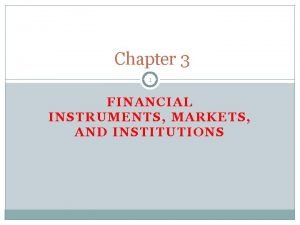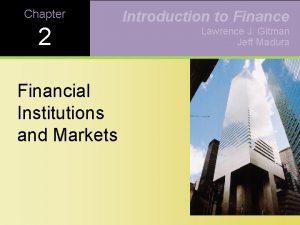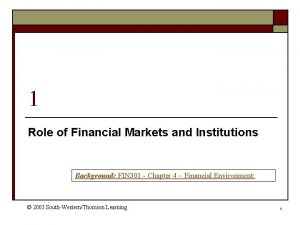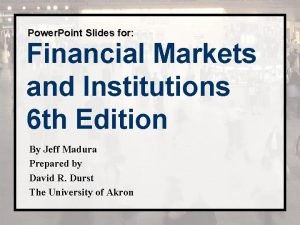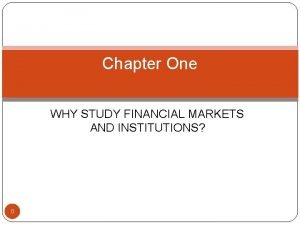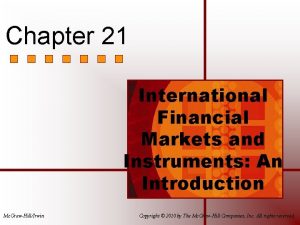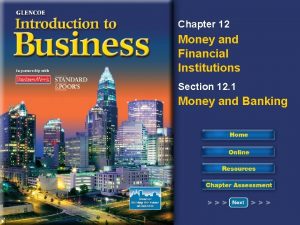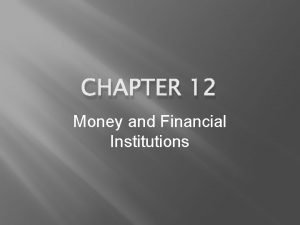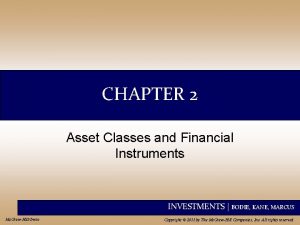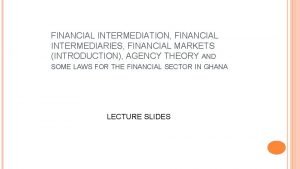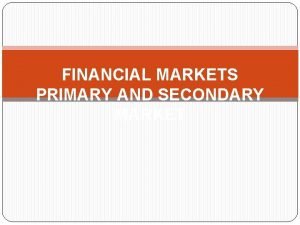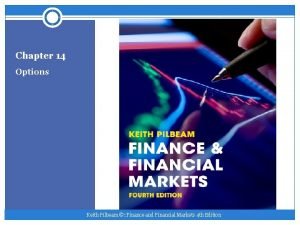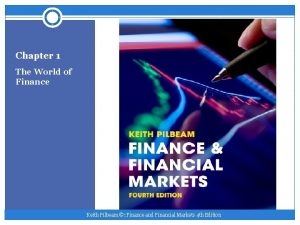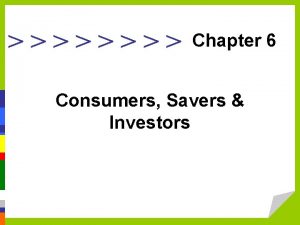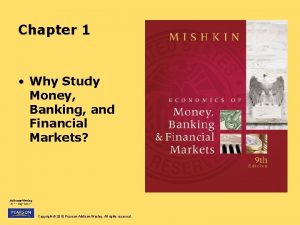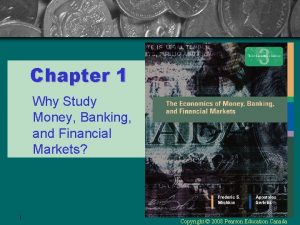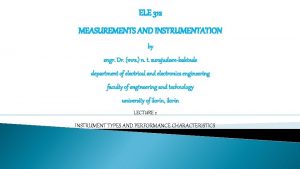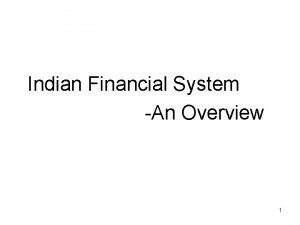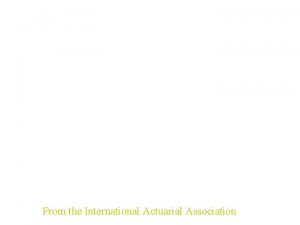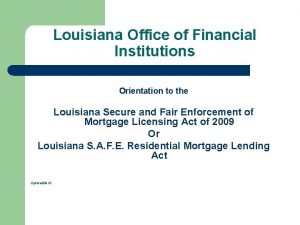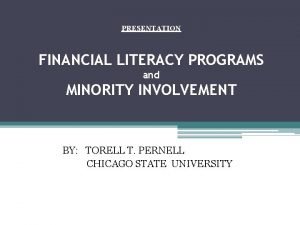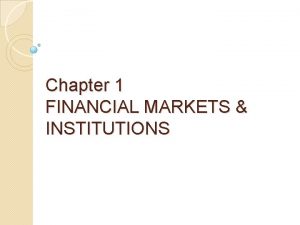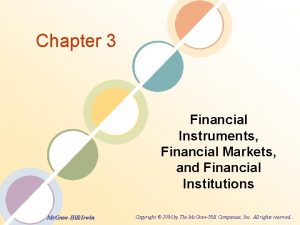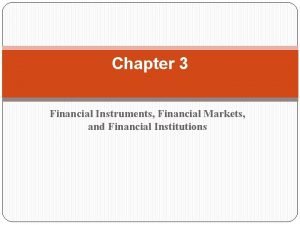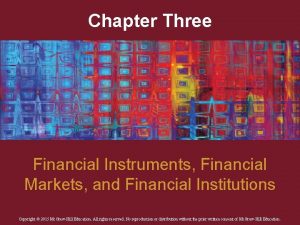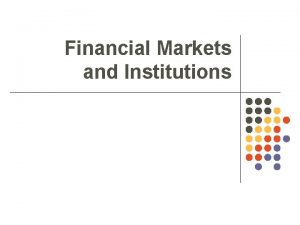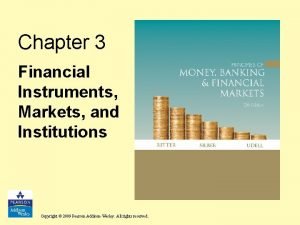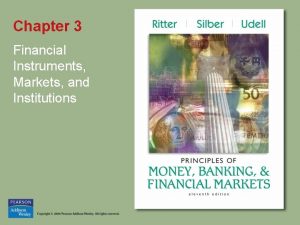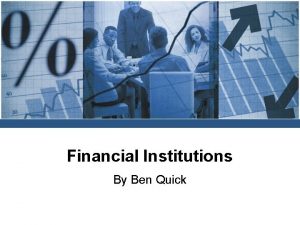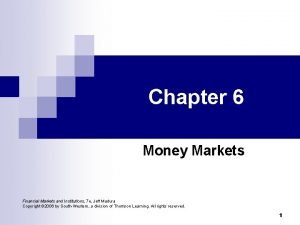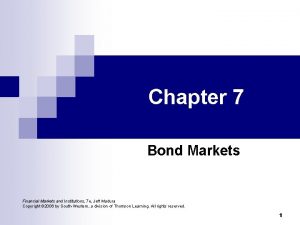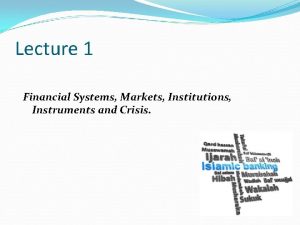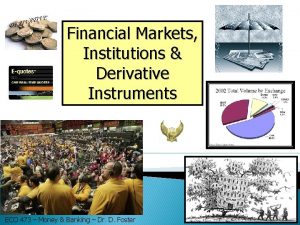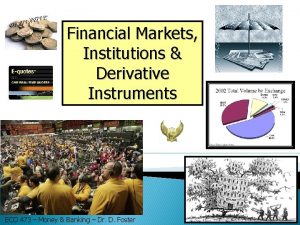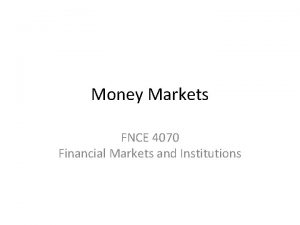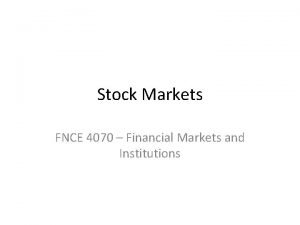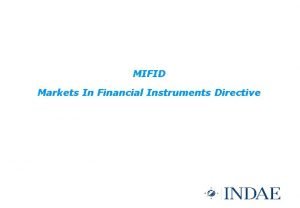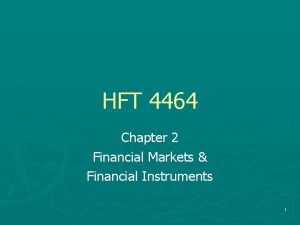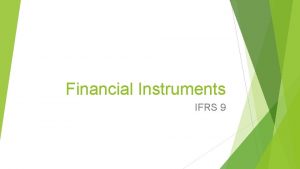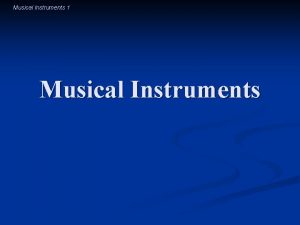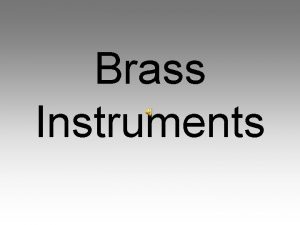Chapter 3 Financial Instruments Markets and Institutions KEY




![Flow of Funds (Cont. ) P. 32 • Funds flow indirectly from lenders [households] Flow of Funds (Cont. ) P. 32 • Funds flow indirectly from lenders [households]](https://slidetodoc.com/presentation_image_h2/7845712e6de676b6b90543f2d913dfcd/image-5.jpg)







![Financial Instruments & Markets (cont) • Both stocks and bonds [securities] are a claim Financial Instruments & Markets (cont) • Both stocks and bonds [securities] are a claim](https://slidetodoc.com/presentation_image_h2/7845712e6de676b6b90543f2d913dfcd/image-13.jpg)



















- Slides: 32

Chapter 3 Financial Instruments, Markets, and Institutions

KEY WORDS AND CONCEPTS • • • Financial Markets Financial Intermediaries Primary Market Secondary Market Securities – Bonds – Stock Dividends Common Stock Copyright © 2004 Pearson Addison-Wesley. All rights reserved. Preferred stock 3 -2

KEY WORDS AND CONCEPTS • Mortgages • Collateral • Derivatives or Derivative financial instruments • Capital Market • Money Market • Financial Intermediaries Banks Mutual Fund Companies Life Insurance Savings and Loans Credit Unions Investment Banks Copyright © 2004 Pearson Addison-Wesley. All rights reserved. 3 -3

Flow of Funds • Financial system provides a way to transfer (move) money from saverlenders to borrower-spenders. – Savers benefit—earn interest – Investors benefit—access to money with greater risk (chinese – Economy benefits—bringing savers and borrowers together Copyright © 2004 Pearson Addison-Wesley. All rights reserved. 3 -4
![Flow of Funds Cont P 32 Funds flow indirectly from lenders households Flow of Funds (Cont. ) P. 32 • Funds flow indirectly from lenders [households]](https://slidetodoc.com/presentation_image_h2/7845712e6de676b6b90543f2d913dfcd/image-5.jpg)
Flow of Funds (Cont. ) P. 32 • Funds flow indirectly from lenders [households] through financial intermediaries [banks or insurance companies] or directly through financial markets [stock exchange/bond markets] to borrowers [business firms, government, or other households] (See next slide and figure 3. 1) Set up a market in class (need 4 students) based on next 2 slides Copyright © 2004 Pearson Addison-Wesley. All rights reserved. 3 -5

Savers/Lenders Borrowers/ Spenders Direct Finance Indirect Finance Money + Fed = Monetary Policy Financial Markets Copyright © 2004 Pearson Addison-Wesley. All rights reserved. Financial Intermediaries 3 -6

Figure 3. 1 Flow of funds from lenders to borrowers P. 32 Copyright © 2004 Pearson Addison-Wesley. All rights reserved. 3 -7

Financial Instruments & Markets p. 33, 34 • Primary Markets – Market for a new security to saver-lenders. – Investment Banks—Sell new securities. • Secondary Markets – Market where securities can be bought and sold • New York Stock Exchange • American Stock Exchange • Over-the-counter (OTC) markets • Shanghai Exchange • Hong Kong Exchange Copyright © 2004 Pearson Addison-Wesley. All rights reserved. 3 -8

Financial Instruments & Markets p. 34 • Bonds – Issued (sold) by governments or companies that need money to pay for projects or finance a company. – Bonds represent borrowing – Different types of bonds • Coupon bonds • Zero coupon bonds • Tax exempt bonds Copyright © 2004 Pearson Addison-Wesley. All rights reserved. 3 -9

Financial Instruments & Markets p. 35 • Stocks mean Ownership • Stockholder owns part of the corporation and receives dividends 红 利 (Hónglì) – from the issuer. – No government stock—individuals cannot “own” part of the government Copyright © 2004 Pearson Addison-Wesley. All rights reserved. 3 -10

Financial Instruments & Markets p. 35 – Types of Corporate stocks • Preferred Stock—Fixed dividends, priority over common stock • Common Stock—Variable dividends, based on company’s profits. • Stock is exchanged (buy and sell) in secondary market Copyright © 2004 Pearson Addison-Wesley. All rights reserved. 3 -11

STOCK CERTIFICATE Copyright © 2004 Pearson Addison-Wesley. All rights reserved. 3 -12
![Financial Instruments Markets cont Both stocks and bonds securities are a claim Financial Instruments & Markets (cont) • Both stocks and bonds [securities] are a claim](https://slidetodoc.com/presentation_image_h2/7845712e6de676b6b90543f2d913dfcd/image-13.jpg)
Financial Instruments & Markets (cont) • Both stocks and bonds [securities] are a claim to a stream of payments [cash flows] in the future – Bonds—Interest payment and face value at maturity – Stocks—Dividends and sales price when sold Copyright © 2004 Pearson Addison-Wesley. All rights reserved. 3 -13

Financial Instruments & Markets p 36, 37 • Mortgages involve Real Estate (land house) – Debt (loan) to buy land and/or building, which is collateral (security) for the lender. – Fixed Rate—Rate of interest is fixed – Variable-Rate—Rate of interest varies depending on financial environment Copyright © 2004 Pearson Addison-Wesley. All rights reserved. 3 -14

Financial Instruments & Markets p 37. 38 • Options and Futures Contracts – An agreement between two parties to exchange a third asset in the future at a stated price • Often called Derivatives because they derive 导出 (Dǎochū) value from other assets Copyright © 2004 Pearson Addison-Wesley. All rights reserved. 3 -15

Financial Instruments & Markets p. 39 • The Capital Market – Exchange of long-term securities—longer than one year – Generally used to secure long-term financing for capital investment • Stock market—Largest part of capital market • House mortgages • Corporate bond market—Held by insurance companies, pension and retirement funds • Local and state government bonds • Government securities – held by the Chinese government for example Copyright © 2004 Pearson Addison-Wesley. All rights reserved. 3 -16

Financial Instruments & Markets p. 40 • The Money Market – Exchange of short-term financial instruments—less than one year – Highly liquid, low risk – Use of a temporary extra amount of funds by banks or businesses • • U. S. Treasury bills—short-term debts of US government Bank Certificates of Deposit Commercial Paper Federal Funds—Exchange of excess/deficient reserves between banks on an overnight basis. Copyright © 2004 Pearson Addison-Wesley. All rights reserved. 3 -17

Financial Intermediaries: Purposes and Profile • Role of Financial Intermediaries – Help moving funds from savers-lenders to borrowers-spenders. – Get funds by issuing their liabilities to public and use money to purchase financial assets • Earn profits on difference between interest paid and earned • Diversify 多元化 (Duōyuán huà) portfolios and minimize risk • Lower transaction costs • Competition lowers interest rates— beneficial to economic growth Copyright © 2004 Pearson Addison-Wesley. All rights reserved. 3 -18

Financial Intermediaries: Purposes and Profile • Financial Institutions in Profile—focus on liabilities and assets – Commercial Banks • Most common type of institution • Range in size from huge (Bank of America, ICBC) to small banks (Bank of Xinzheng) • Major source of funds used to be demand deposits of public, but now rely more on “other liabilities (funds)” • Also accept savings and time deposits—interest earning Copyright © 2004 Pearson Addison-Wesley. All rights reserved. 3 -19

Financial Intermediaries: Purposes and Profile (Cont. ) P. 43, 44 – Commercial Banks (Cont. ) • Purchase wide variety of assets –short-term government securities –long-term business loans –Home mortgages MAIN PURPOSE AND SOURCE OF REVENUE FOR BANKS – LOANS, LOANS!!! Copyright © 2004 Pearson Addison-Wesley. All rights reserved. 3 -20

Financial Intermediaries: Purposes and Profile (Cont. ) p. 44 • Financial Institutions in Profile (Cont. ) – Life Insurance Companies • Insure against death • Receive funds in form of premium payments • Use of funds is based on mortality statistics— predict when funds will be needed • Invest in long-term securities—high yield – long-term corporate bonds – Long-term commercial mortgages Copyright © 2004 Pearson Addison-Wesley. All rights reserved. 3 -21

Financial Intermediaries: Purposes and Profile (Cont. ) p. 44 • Financial Institutions in Profile (Cont. ) – Pension and Retirement 退休 Tuìxiū Fund Companies • Saving for the future • Invest in long-term corporate bonds & good stocks. – Mutual Fund Companies • Stock or bond market related institutions • Pool funds from many people • Invest in wide variety of securities—minimize risk Copyright © 2004 Pearson Addison-Wesley. All rights reserved. 3 -22

Financial Intermediaries: Purposes and Profile (Cont. ) p. 45 • Financial Institutions in Profile (Cont. ) – Money Market Mutual Funds • Individuals purchase shares in the fund • Fund invests in highly liquid short-term money market instruments – large-size negotiable CD’s – Treasury bills – high-grade commercial paper Copyright © 2004 Pearson Addison-Wesley. All rights reserved. 3 -23

Financial Intermediaries: Purposes and Profile (Cont. ) p. 45 • Financial Institutions in Profile (Cont. ) – Savings and Loan Associations [S&L’s] • Get funds through savings deposits • Use funds to make home mortgage loans • Perform same functions as commercial banks – issue checking accounts (demand deposits) – make consumer and business loans – Commercial and Consumer Finance Companies • Lend money for consumer purchases or business firms to help them grow their business Copyright © 2004 Pearson Addison-Wesley. All rights reserved. 3 -24

Financial Intermediaries: Purposes and Profile (Cont. ) p. 45 • Financial Institutions in Profile (Cont. ) – Property and Casualty Insurance 保� (Bǎoxiǎn) Companies • Insure homeowners and businesses against losses • Receive premiums • Need to be liquid due to uncertainty of claims Copyright © 2004 Pearson Addison-Wesley. All rights reserved. 3 -25

Financial Intermediaries: Purposes and Profile (Cont. ) P. 45, 46 • Financial Institutions in Profile (cont) – Credit Unions • Organized as cooperatives for people with common interest • Members buy shares [deposits] and can borrow • Changes in the law in 1980 broadened their powers –checking [share] accounts –make long-term mortgage loans Copyright © 2004 Pearson Addison-Wesley. All rights reserved. 3 -26

Copyright © 2004 Pearson Addison-Wesley. All rights reserved. 3 -27

CHAPTER SUMMARY p. 32 • Direct Finance – Funds flow directly from savers/borrowers through financial markets (for example, the stock exchange) • Indirect Finance – Funds flow through financial intermediaries like banks. Copyright © 2004 Pearson Addison-Wesley. All rights reserved. 3 -28

CHAPTER SUMMARY p. 34, 35 • FINANCIAL INSTRUMENTS: Securities – Broad name for all types of stocks and bonds. Bonds – Governments or companies are borrowing funds (debt) to finance projects or growth. Stocks – Investing in a company means ownership. May get dividends. Securities (bonds and stocks) represent a claim to future payments. Copyright © 2004 Pearson Addison-Wesley. All rights reserved. 3 -29

CHAPTER SUMMARY p. 36 -38 • FINANCIAL INSTRUMENTS (CONT): Mortgages – Borrowing to buy land or buildings or houses Derivatives – Financial instruments that derive their value from other assets. Options and Futures – Agreements between two people to exchange an asset in the future for a certain price. Copyright © 2004 Pearson Addison-Wesley. All rights reserved. 3 -30

CHAPTER SUMMARY p. 33, 34, 38 -40 • FINANCIAL MARKETS Primary Markets – New securities that have never been issued or sold Secondary Markets – Existing securities Capital Market – Long term financial instruments for more than a year p. 38, 39 Money Market – Short term less financial instruments less than a year. P 38 and 40 Copyright © 2004 Pearson Addison-Wesley. All rights reserved. 3 -31

CHAPTER SUMMARY • FINANCIAL INTERMEDIARIES & INSTITUTIONS (Companies) 1. Commercial Banks 2. Life Insurance Companies 3. Pension Fund Companies 4. Mutual Fund Companies 5. Savings and Loan 6. Credit Unions Copyright © 2004 Pearson Addison-Wesley. All rights reserved. 3 -32
 Basic flow of funds through the financial system
Basic flow of funds through the financial system Financial markets and institutions chapter 1
Financial markets and institutions chapter 1 Financial markets and institutions jeff madura ppt
Financial markets and institutions jeff madura ppt Financial institutions and markets lecture notes ppt
Financial institutions and markets lecture notes ppt Madura j. financial markets and institutions
Madura j. financial markets and institutions Functions of financial markets and institutions
Functions of financial markets and institutions Madura j. financial markets and institutions
Madura j. financial markets and institutions Why study financial markets and institutions
Why study financial markets and institutions International financial markets and instruments
International financial markets and instruments Chapter 12 money and financial institutions
Chapter 12 money and financial institutions Chapter 12 money and financial institutions
Chapter 12 money and financial institutions Chapter 2 asset classes and financial instruments
Chapter 2 asset classes and financial instruments Types of financial intermediaries
Types of financial intermediaries Savers and investors role in financial markets
Savers and investors role in financial markets How do primary and secondary financial markets differ
How do primary and secondary financial markets differ Efficient capital allocation
Efficient capital allocation Foreign exchange and international financial markets
Foreign exchange and international financial markets Pilbeam k. finance and financial markets
Pilbeam k. finance and financial markets Keith pilbeam
Keith pilbeam Chapter 6 consumers savers and investors
Chapter 6 consumers savers and investors Why study money banking and financial markets
Why study money banking and financial markets Why study money banking and financial markets
Why study money banking and financial markets Example of null type instrument
Example of null type instrument Pressure measuring devices
Pressure measuring devices Functions of financial institutions
Functions of financial institutions Management of financial institutions daibb pdf
Management of financial institutions daibb pdf Functions of financial system
Functions of financial system Types of financial institutions
Types of financial institutions Enterprise risk management for financial institutions
Enterprise risk management for financial institutions Louisiana office of financial institutions
Louisiana office of financial institutions Finanial institutions accounting
Finanial institutions accounting Financial literacy at minority serving institutions
Financial literacy at minority serving institutions Acrostic poem adalah
Acrostic poem adalah
